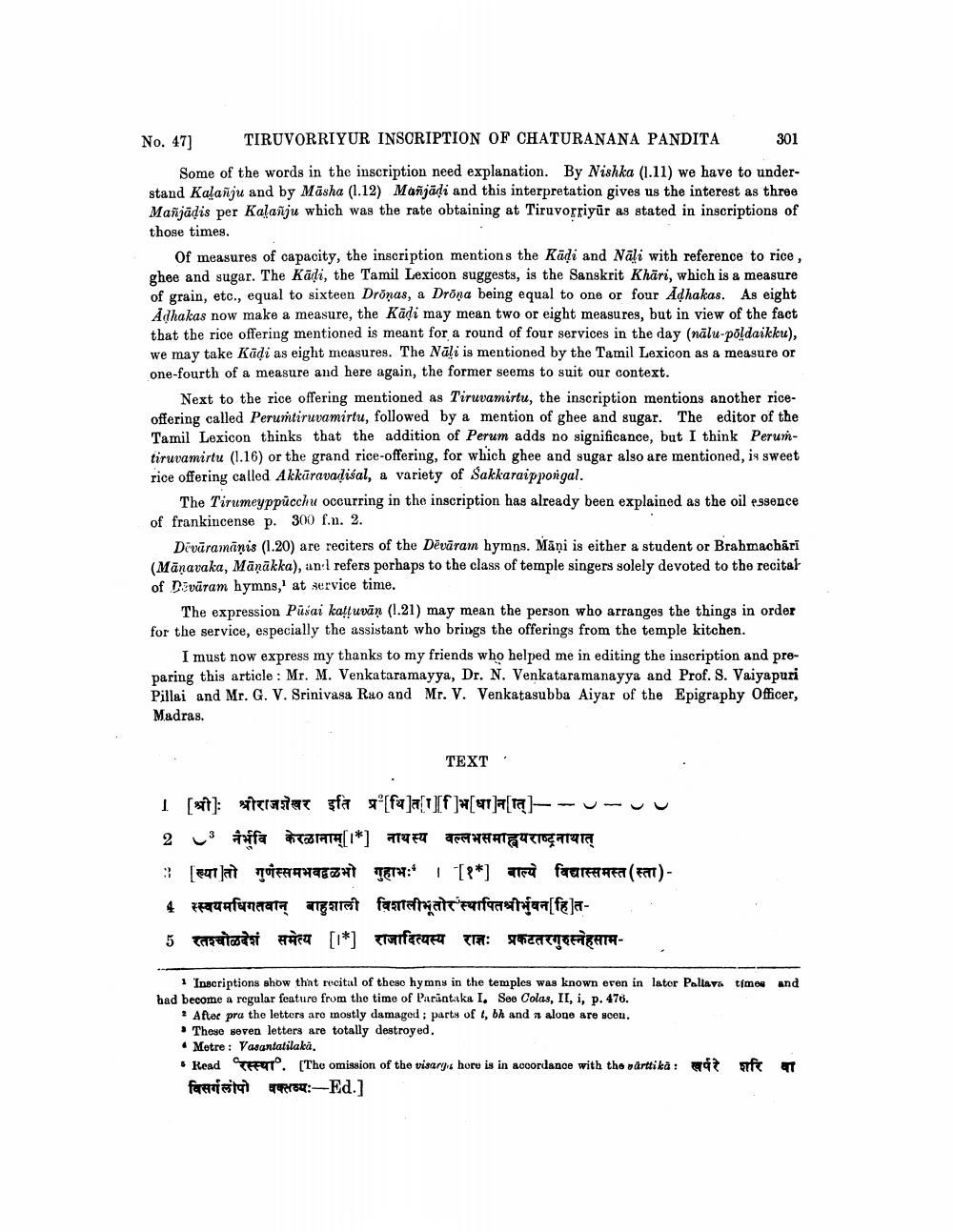________________
No. 47] TIRUVORRIYUR INSCRIPTION OF CHATURANANA PANDITA 301
Some of the words in the inscription need explanation. By Nishka (1.11) we have to understand Kalasju and by Mäsha (1.12) Mañjādi and this interpretation gives us the interest as three Mañjādis per Kalanju which was the rate obtaining at Tiruvorriyūr as stated in inscriptions of those times.
Of measures of capacity, the inscription mentions the Kādi and Nali with reference to rice, ghee and sugar. The Kādi, the Tamil Lexicon suggests, is the Sanskrit Khari, which is a measure of grain, etc., equal to sixteen Dronas, a Dröna being equal to one or four Adhakas. As eight Adhakas now make a measure, the Kādi may mean two or eight measures, but in view of the fact that the rice offering mentioned is meant for a round of four services in the day (mälu-poldaikku), we may take Kādi as eight measures. The Nāli is mentioned by the Tamil Lexicon as a measure or one-fourth of a measure and here again, the former seems to suit our context.
Next to the rice offering mentioned as Tiruvamirtu, the inscription mentions another riceoffering called Perumtiruvamirtu, followed by a mention of ghee and sugar. The editor of the Tamil Lexicon thinks that the addition of Perum adds no significance, but I think Perumtiruvamirtu (1.16) or the grand rice-offering, for which ghee and sugar also are mentioned, is sweet rice offering called Akkūravališal, a variety of Sakkaraippongal.
The Tirumeyppūcchu occurring in the inscription has already been explained as the oil essence of frankincense p. 300 f.n. 2.
Divīramanis (1.20) are reciters of the Devaram hymns. Māņi is either a student or Brahmachari (Mänavaka, Mānākka), an: refers porhaps to the class of temple singers solely devoted to the recital of Devaram hymns, at service time.
The expression Pūšai kattuvān (1.21) may mean the person who arranges the things in order for the service, especially the assistant who brings the offerings from the temple kitchen.
I must now express my thanks to my friends who helped me in editing the inscription and preparing this article: Mr. M. Venkataramayya, Dr. N. Venkataramanayya and Prof. S. Vaiyapuri Pillai and Mr. G. V. Srinivasa Rao and Mr. V. Venkatasubba Aiyar of the Epigraphy Officer, Madras.
TEXT:
1 [mt]: stratat fa q'[fa]a[11f ]a[1]a[ra]--U U U 2 3 न वि केरळानाम्[1*] नाथस्य वल्लभसमाह्वयराष्ट्रनाथात् :: [EU at TOERT+262H1 TET*:* I [*] ara fa THT (FAT)4 स्स्वयमधिगतवान् बाहुशाली विशालीभूतोर स्थापितश्री वन[हि]त5 autodai H [1*] Torfatura TR: CATTOCHTA
time
and
1 Inscriptions show that recital of these hymns in the temples was known even in lator Pallave had become a regular feature from the time of Parantaka I. See Colas, II, i, p. 470.
After pra the letters are mostly damaged ; parts of 1, bh and alone are soon. These seven letters are totally destroyed. Metre : Vasantatilakā. * Read TAT. [The omission of the visar4 hore is in accordance with the vårttika: fatatal #54:-Ed.]
afa




